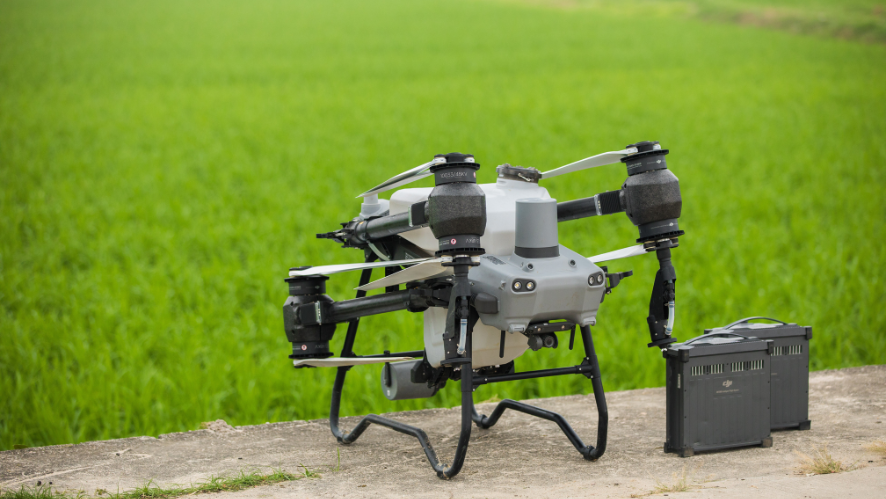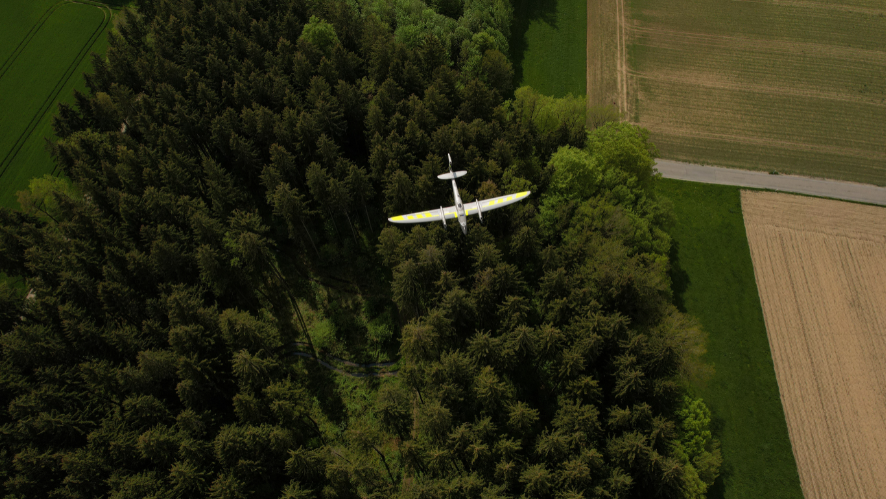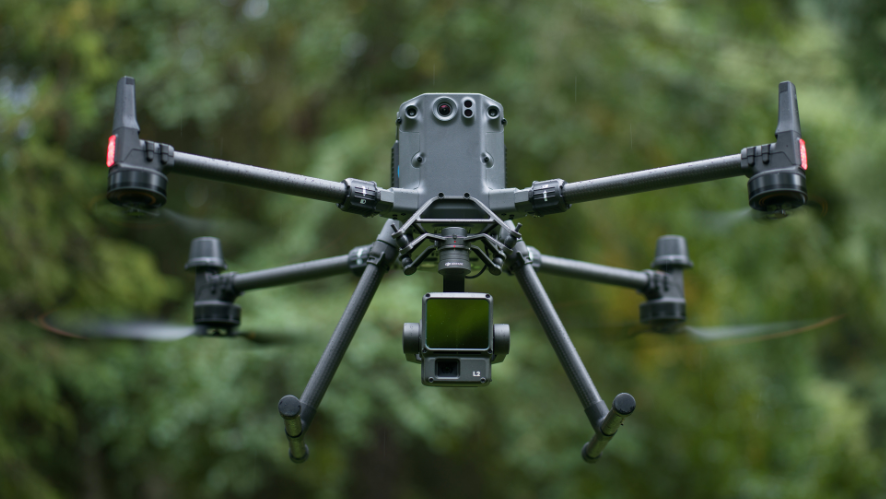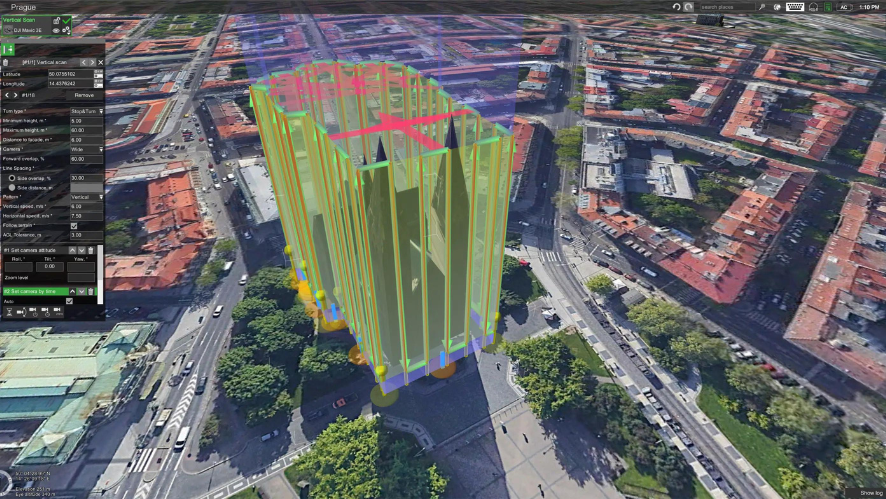SERIE ZENMUSE H20
Concentrated power
“H” for hybrid
This multi-sensor tool transforms what we understand as operational efficiency into missions. Its integrated design and unique intelligence offer unprecedented imaging capabilities for a variety of commercial uses.
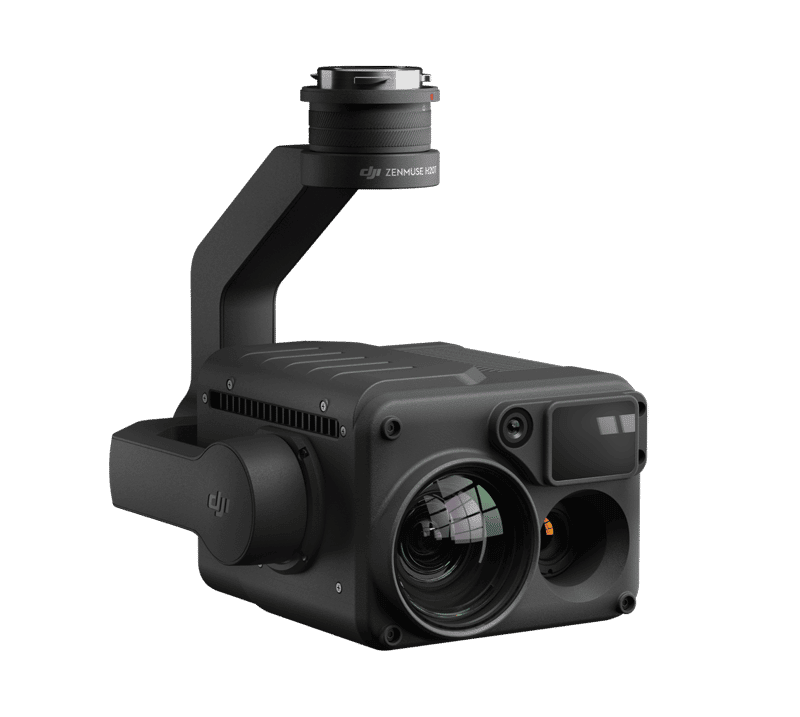
12 MP wide-angle camera
20 MP zoom camera
Radiometric thermal camera
Laser rangefinder
IP protection Operating temperature from -20 to 50 °C 44
Active Image Stabilisation and EIS
Night scene mode
All the sensors you need in one
Capture everything, near and far, in true colour or thermal. Measures the distance to an object up to 1200 m thanks to the integrated laser range finder (LRS). This powerful integrated payload unleashes advanced intelligent capabilities for DJI’s industrial drone platforms.
-20 MP zoom camera
– 12 MP wide-angle camera
– Laser rangefinder with 1200 m max. range
– 20 MP zoom camera
– 12 MP wide-angle camera
– Laser range finder with 1200 m max. range
– 640×512 px radiometric thermal camera

Powerful zoom camera
Saving distances
- 23× hybrid optical zoom, max. 200× zoom
- 1/1.7″ 20 MP CMOS sensor
- Video resolution: 4K/30 fps
Everything under control
WIDE-ANGLE CAMERA
- Equivalent focal length: 24 mm
- DFOV: 82.9°
- 1/2.3″ 12 MP CMOS sensor
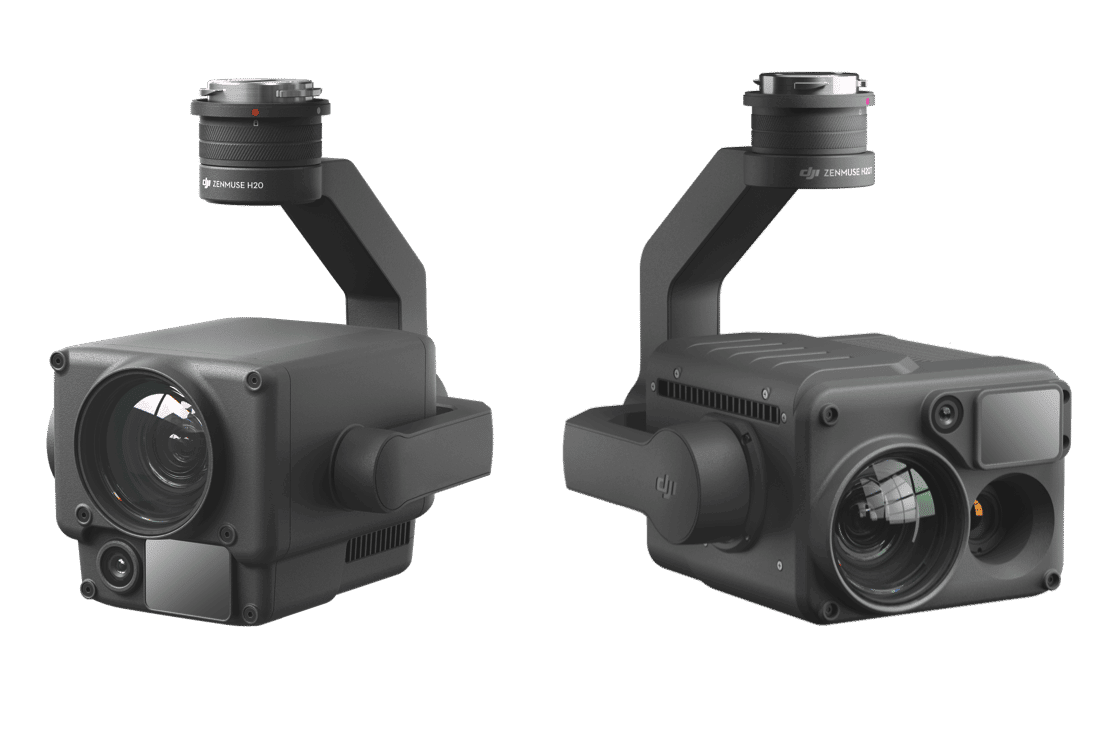
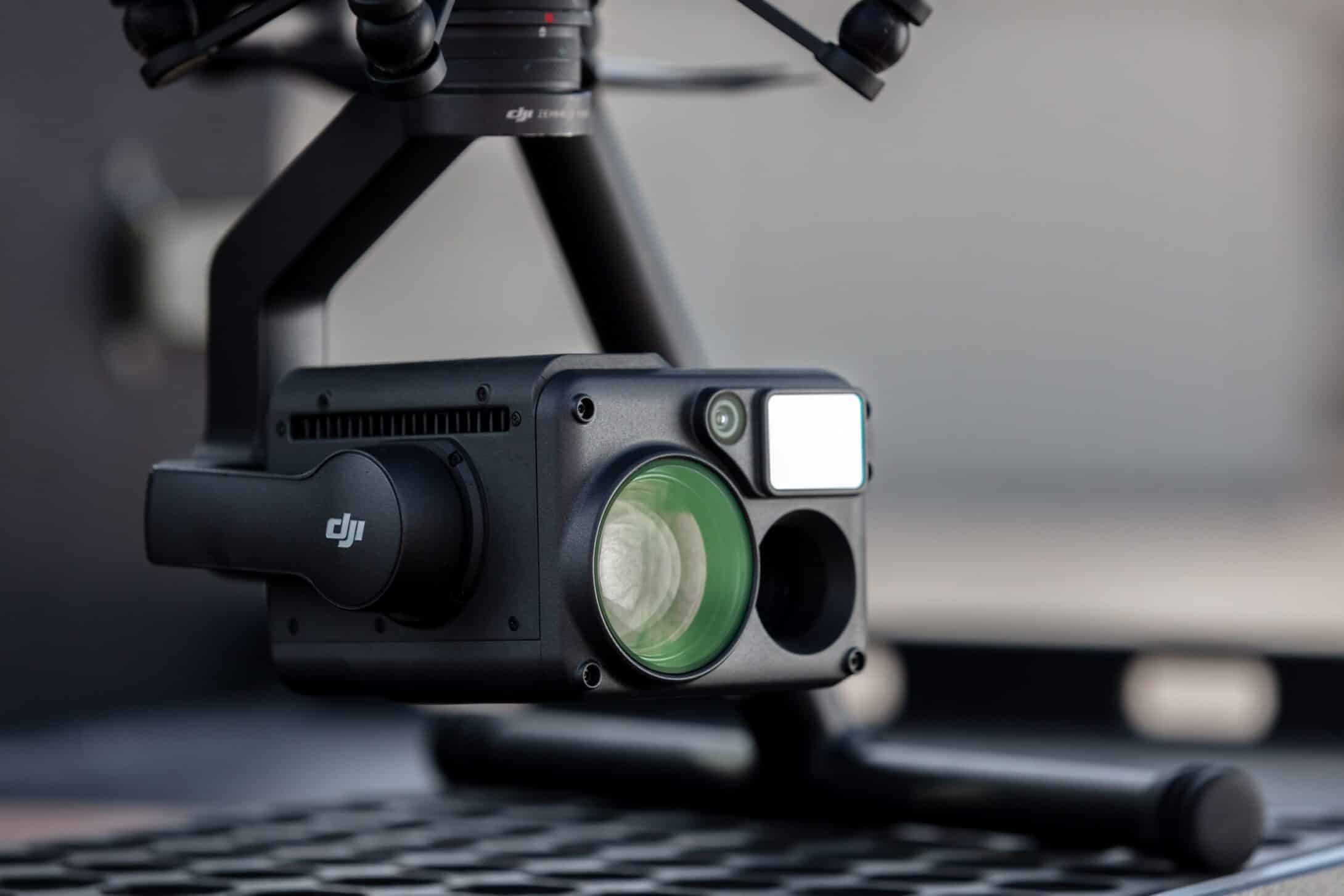
LASER RANGE FINDER
Accurate distance data
- Rango: 3-1200 m
- Accuracy: ± (0.2 m + D × 0.15 %)
Radiometric thermal camera
- DFOV: 40.6°
- Resolution: 640×512
- Frame rate: 30 fps
- Sensibilidad térmica: ≤50 mk a f1.0 (NEDT)
COMPLETE USER INTERFACE
The new integrated user interface allows you to quickly switch between a zoom, wide-angle or thermal view, as well as preview the zoom FOV in the thermal or wide-angle camera view.
- Artificial intelligence targeting (AI Spot-Check)
- High-Res Grid Photo (High-Res Grid Photo)
- Pin Point
- Smart Track
Automates routine inspections and captures consistent results every time. On-board artificial intelligence recognises the target of interest previously marked on subsequent automated missions and ensures consistent framing.
Frame a specific area in the wide-angle camera view, and the zoom camera will automatically capture a set of 20 MP images of that area.
These images are then stored together with an overall image for a more detailed display.
To mark an object in the visualization, a quick tap is all it takes and advanced data fusion algorithms will immediately provide its coordinates.
Identifies and tracks moving targets such as people, vehicles and boats with the auto-zoom function, while continuously acquiring the dynamic location of the target.
ACCURATE TEMPERATURE MEASUREMENT
Get an accurate measurement of the temperature of a site or asset from the air to avoid any risk.
Spot Meter
Touch a point to get a real-time reading of the surface temperature.
Area measurement
Select an area to view the highest, lowest and average temperatures.

INTELLIGENT FEATURES
- Temp Alarm
Receive immediate notifications in DJI Pilot when object temperatures exceed preset alert values.
- Isotherms
View a certain temperature band to identify what is important.
- Color Palettes
Adjusts the colours applied to the thermal data for each of the scenarios.
- Gain Modes
Adjusts the colours applied to the thermal data for each of the scenarios. Adjusts the gain modes to modify the temperature range captured. The high gain mode covers a small temperature range, but is more sensitive to temperature differences. On the other hand, the low gain mode covers a larger temperature range.
- Images R-JPEG
The images captured by the Zenmuse H20T are in R-JPEG format and incorporate temperature information. By importing these images into the DJI Thermal Analysis Tool, you can measure temperature and adjust parameters such as emissivity and reflected temperature.
FREQUENT QUESTIONS
FAQ
How many models are in the Zenmuse H20 Series?
The Zenmuse H20 Series has 2 models: the Zenmuse H20 (Triple-sensor model with a wide-angle camera, a zoom camera, and a laser rangefinder) and the Zenmuse H20T (quad-sensor model with a wide-angle camera, a zoom camera, a laser rangefinder, and a radiometric thermal camera)
What’s the Ingress Protection Level?
Under controlled laboratory conditions, the Zenmuse H20 Series meets the IP44 protection level under the IEC60529 standard. The protection level is not permanently effective, and will weaken with wear and tear.
- Make sure the gimbal connector interface and gimbal surface are dry and free of moisture before installing the gimbal.
- Before use, make sure that the gimbal is firmly installed onto the aircraft, and the SD card cover is clean, free of foreign objects, and securely closed.
- Before opening the SD card cover, wipe the surface of the body clean.
What are the image resolutions of the cameras?
Radiometric thermal camera: R-JPEG, 640×512 px
Wide-angle camera: JPEG, 4056×3040 px
Zoom camera: JPEG, 5184×3888 px
What are the video resolutions of the cameras?
Radiometric thermal camera: 640×512@30fps
Wide-angle camera:1920×1080@30fps
Zoom camera: 3840×2160@30fps / 1920×1080@30fps
Which video format is supported?
MP4 encoded with H.264 compression
What are the zoom levels of the H20 Series?
23× hybrid optical zoom, 200× max zoom
What is the minimum focusing distance of the visible cameras of the Zenmuse H20 Series payloads?
The higher the zoom factor, the longer the focusing distance.
1×-2.8×, the minimum focusing distance is 1 m.
2.9×-3.9×, the minimum focusing distance is 2 m.
4×-4.6×, the minimum focusing distance is 3 m.
4.7×-14.2×, the minimum focusing distance is 5 m.
14.3×-200×, the minimum focusing distance is 8 m.
If the object is within the minimum focusing distance, the camera will not be able to focus. For example, if the aircraft/payload is 5 m away from a pylon, the camera will not be able to focus at a zoom level greater than 14.2×.
What factors affect the accuracy of the laser rangefinder?
Laser rangefinders measure distance using the time of flight of light. Its accuracy may be affected in environments where this time is affected. The range will be reduced in situations with smoke, rain, snow, dust or other environmental elements, and the values obtained may be incorrect.
When measuring an object with glass or transparent components:
If the glass is at a moderate distance, the distance to it can be measured (but not to the object behind the glass). It is possible that the glass may reflect the laser to another location, giving an incorrect result. If the glass surface is very smooth or very close, the light will pass through it and detect the object behind it, but the range will be greatly reduced.
At what frame rate does the Zenmuse H20T thermal camera record?
30 fps
How accurate is the thermal measurement of the Zenmuse H20T?
Accuracy is ±2 °C or ±2 % (whichever is greater). (Measured at 25 °C in a windless laboratory at a distance of 5 m from a black body).
Note: Black bodies have different emissivity levels, the above measurement is based on a particular black body and should only be used for reference.
What factors affect the temperature measurement accuracy of the Zenmuse H20T?
The reflectivity of the objects: shiny metals have a higher reflectivity and will result in lower accuracy, giving lower temperatures than the real ones.
The temperature of the background radiation: on a sunny day with a clear sky the accuracy will be affected to a lesser extent than on a cloudy day.
Ambient temperature and humidity: the higher the temperature and humidity, the more likely it is that the measurement will be affected and the accuracy will drop.
The distance between the camera and the object: the farther away the object is from the camera, the lower the accuracy.
What is the difference between the high and low gain modes in the thermal camera of the Zenmuse H20T?
High gain mode: measures a smaller temperature range but with higher accuracy. The temperature range is -40 to 150 °C.
Low gain mode: measures a larger temperature range, but with lower accuracy. The temperature range is -40 to 550 °C.
Can the Zenmuse H20T thermal camera be digitally zoomed?
Yes, it has two, four and eight times digital zoom.
What is the Zenmuse H20T flat field calibration or FFC?
Flat field calibration is used to optimize thermal image quality and to make temperature changes more easily visible. You can disable the automatic FFC in the settings to activate it manually.
What different ways are there to measure temperature using a Zenmuse H20T?
There are two forms: Spot Meter measures the temperature of a single point, and Area Measurement measures the different temperatures occurring within an area.
Are different versions of the Zenmuse H20T available with different focal lengths, what is the focal length of your thermal camera?
The Zenmuse H20T has only one model. Its thermal camera has a focal length of 13.5 mm (f1.0). It is a distance equivalent in 35 mm to 58 mm. The diagonal field of view is 40.6°.
What software can I use to process thermal images taken with the Zenmuse H20T?
You can process them with the DJI Thermal Analysis Tool. Download it here: https://www.dji.com/es/zenmuse-h20-series/downloads
What can I do if the lens fogs up?
The Zenmuse H20 series is designed to prevent water damage to its components. However, if the humidity is too high or if the instrument is exposed to rain, water vapor may enter the chamber. When turned on, the electrical components will heat up and cause any moisture that has entered to evaporate, eventually condensing on contact with the lens, resulting in fogging. This can usually be solved by turning on the aircraft and waiting for the vapor to dissipate. If you are not using the instrument, we recommend that you store it in a designated case or in a cool, dry place with a relative humidity of less than 40%.
What is Night Scene mode?
In Night Scene mode, the camera will change the infrared filter and optimize the ISP settings for low light conditions.
What is High-Res Grid Photo Mode?
In DJI Pilot, you can select an area in the wide-angle view and a wide-angle image will be taken while the stabilizer automatically rotates and captures a series of photos at 20 MP of the indicated area at the currently selected zoom level. All captured images will be saved in a subdirectory on the SD card, generating an HTML file that can be opened with a web browser to view the overall image and detailed close-ups.
What is the maximum capacity of the microSD card?
128 GB. We recommend using a UHS-I microSD card with a speed grade 3.
What applications are supported?
At this time, the Zenmuse H20 series is only compatible with the Android version of DJI Pilot.
Can photos and videos be captured at the same time?
Yes. This requires a firmware update.
Is it possible to take pictures with countdown?
Yes. This requires a firmware update.
What drone platforms are they compatible with?
With the Matrice 300 RTK. Upgrades both the aircraft and the remote control.
On which stabilizer connector can they be mounted?
Both versions can be mounted on any of the M300 RTK connectors.
How do I update the Zenmuse H20 series firmware?
Before upgrading, make sure that the aircraft is powered off, the instrument is properly mounted on the aircraft, the microSD card has sufficient storage space, and the Intelligent Flight Battery has sufficient power supply. Visit the official DJI website and go to the download section of the Zenmuse H20 product page. Download the latest firmware package.
Save the downloaded firmware package to the root directory of the microSD card. Insert the microSD card into the microSD card slot of the instrument. Turn on the aircraft and the stabilizer will perform a self-test process. Turn on the aircraft and the stabilizer will perform a self-test process.
Once the update is complete, reboot all devices.
Description of the stabilizer update status:
4 short beeps: firmware update detected, device ready to be updated.
1 long beep: the firmware is updating, do not stop the update.
1 long beep and 2 short beeps: firmware was successfully updated.
Long continuous beep: failed to update firmware, please try again. If you need assistance, you can contact DJI technical support.
Notes:
- Stores only one firmware version on the microSD card. If you store more than one version on the microSD card, the update cannot be performed.
- Do not turn off the aircraft or disassemble the instrument from the aircraft during the upgrade, as this may damage the stabilizer.
What safety precautions should be taken into account when using the Zenmuse H20 series?
Do not point the camera lens at high-energy sources, such as the sun, lava or laser beams. The temperature of the observation objects should not exceed 800 °C, as this could cause irreversible damage to the camera.
Do not place the camera in direct sunlight, in poorly ventilated locations or near heat sources.
Do not turn the camera on and off too often. Wait at least 30 seconds before turning the camera back on, as this may affect the life of the camera chips.
Do not hot-swap the microSD card during use.
Do not touch the camera lens or scratch it with hard objects, as this could result in blurry images.
Please use a soft, dry cloth to clean the surface of the camera lens. Do not use alkaline detergents. Do not use alkaline detergents.
Please store the payload in a designated case that is kept dry and ventilated.
For what scenarios can I use the Zenmuse H20 Series?
The Zenmuse H20 Series delivers useful insights in a variety of scenarios, for example, public safety applications including firefighting, fire prevention, search and rescue, and traffic law enforcement; energy industry application including asset and equipment inspection, geothermal energy exploration, and oil and gas inspection.
Can I use the Zenmuse H20 Series for aerial surveying?
The Zenmuse H20 Series was not designed specifically to meet the accuracy requirements for aerial surveying, but you can use the wide-angle camera to capture images in Mapping missions in the DJI Pilot App.
SPECS
Access to technical specifications
GENERAL
Weight
|
Zenmuse H20: 678±5 g Zenmuse H20T: 828±5 g
|
Dimensions
|
Zenmuse H20: 150 × 114 × 151 mm Zenmuse H20T: 167 × 135 × 161 mm
|
Protection index
|
IP44
|
Operating temperature
|
-20° to 50° C (Temperature Measurement is only available between -10° to 50° C)
|
Storage Temperature
|
−20 a 60 °C
|
Laser safety
|
Clase 1M (IEC 60825-1:2014)
|
Supported Aircraft
|
Matrice 300 RTK
|
Gimbal
Rango de vibración angular
|
±0.01°
|
Support
|
Detachable
|
Controllable Range
|
Pitch: -120° to +30° Yaw: ±320°
|
Mechanical Range
|
Pitch: -132.5° to +42.5° Yaw: ±330° Roll: -90° to +60°
|
Zoom Camera
Sensor
|
CMOS 1/2.7″, 20 MP
|
Lens
|
DFOV: 66.6-4° Focal length: 6.83-119.94 mm (equivalent: 31.7-556.2 mm) Aperture: f/2.8-f/11 (normal), f/1.6-f/11 (night scene) Focus: 1 m to ∞ (wide), 8 m to ∞ (telephoto)
|
Focus Mode
|
MF/AF-C/AF-S
|
Exposure Mode
|
Auto/Manual
|
Exposure Compensation
|
3.0 (1/3 increments)
|
Metering Method
|
Spot metering, Center-weighted metering
|
AE LOCK
|
Supported
|
Electronic shutter speed
|
1~1/8000 s
|
ISO Range
|
Video: 100-25600 Photo: 100-25600
|
Video Resolution
|
3840×2160 a 30 fps, 1920×1080 a 30 fps
|
Video formats
|
MP4
|
Video subtitles
|
Supported
|
Photo size
|
5184×3888
|
Photo Format
|
JPEG
|
Wide Camera
Sensor
|
1/2.3″ CMOS, 12 MP
|
Lens
|
DFOV: 82.9° Focal length: 4.5 mm (equivalent: 24 mm) Aperture: f/2.8 Focus: 1 m to ∞
|
Exposure Mode
|
Auto
|
Exposure Compensation
|
3.0 (1/3 increments)
|
Metering Method
|
Spot metering, Center-weighted metering
|
AE LOCK
|
Supported
|
Shutter Speed
|
1~1/8000 s
|
ISO Range
|
Video: 100-25600 Photo: 100-25600
|
Video Resolution
|
1920×1080 a 30 fps
|
Video formats
|
MP4
|
Video subtitles
|
Supported
|
Photo size
|
4056×3040
|
Photo Format
|
JPEG
|
THERMAL CAMERA(ZENMUSE H20T)
Sensor
|
Uncooled VOx Microbolometer
|
Lens
|
DFOV:40.6° Focal length: 13.5 mm (58 mm equivalent) Aperture: f/1.0 Focus: 5 m to ∞
|
Digital Zoom
|
1×,2×,4×,8×
|
Video Resolution
|
640×512 a 30 Hz
|
Video formats
|
MP4
|
Image resolution
|
640×512
|
Image Format
|
R-JPEG (16 bits)
|
Pixel Pitch
|
12 μm
|
Spectral Band
|
8-14 μm
|
Sensitivity (NETD)
|
≤50 mK a f/1.0
|
Temperature Measurement Method
|
Spot Meter, Area Measurement
|
Scene Range
|
-40 °C to 150 °C (High Gain) -40 °C to 550 °C (Low Gain)
|
Temperature alert
|
Supported
|
FFC
|
Auto/Manual
|
Palette
|
White hot/Fulgurite/Iron Red/Hot Iron/Medical/Arctic/Rainbow 1/Rainbow 2/Tint/Black Hot
|
LASER RANGEFINDER
Wave length
|
905 nm
|
Measurement range
|
3-1200 m (to a vertical surface with ≥12m diameter and 20% reflection rate)
|
Measurement accuracy
|
± (0.2 m + D × 0.15 %) D is the distance to a vertical surface
|
Features
Hybrid Optical Zoom
|
23×(DFOV:4°,EQV:556.2mm)
|
Max. Zoom
|
200×(DFOV:0.5°,EQV:4800mm)
|
One Click Capture
|
One click to save the video or picture of 3 cameras (zoom, wide and thermal camera) simultaneously
|
Point to Aim
|
Double click on the wide/thermal camera view, then the system will automatically move the gimbal to focus on the point of interest
|
High-Res Grid Photo
|
Frame an area of interest in wide camera view, and the zoom camera will automatically capture a set of 20 MP images of the area. These images are stored together with an overview image that can be viewed in greater detail.
|
Night Scene
|
Supported (zoom camera)
|
Timestamp
|
Including GPS, date, and time
|
Storage
Supported SD Card
|
MicroSD card (Max capacity: 128 GB, UHS-1 Speed Grade 3 required)
|
Supported file systems
|
FAT32 (≤32 GB), exFAT (>32 GB)
|
Recommended microSD Cards3
|
Toshiba EXCERIA PRO 32 GB microSDHC UHS-II SanDisk Extreme PRO 32 GB A1 SDHC UHS-I U3 V30 Toshiba EXCERIA PRO 64 GB microSDXC UHS-II SanDisk Extreme PRO 64 GB A2 SDXC UHS-I U3 V30 Samsung EVO 128 GB microSDXC U3 UHS-I Toshiba EXCERIA M303E 32 GB microSDHC UHS-I Toshiba EXCERIA M303E 64 GB microSDXC UHS-I Toshiba EXCERIA M303E 64 GB microSDXC UHS-I Toshiba EXCERIA M303 128 GB microSDXC UHS-I Samsung EVO 64 GB microSDXC U3 UHS-I
|







